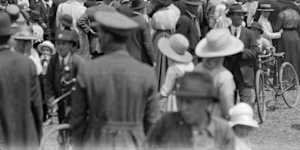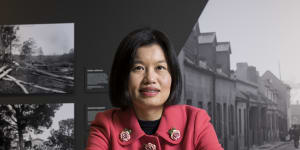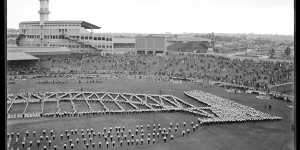It was one of many riddles that experts faced trying to identify people,places and events in 200,000 historic glass negatives dating from 1870 to 1940s. Made to record and advertise the NSW Government’s programs and works,many had no title at all. Some were lumped together as miscellaneous,or by the name of the nearest road.

Crowd around the aeroplane:This image shows the Smith brothers arriving at Mascot airport after their record breaking flight in 1920.Government Printing Office,Sydney Living Museums
Other than the title of the image,“Crowd around the aeroplane,Mascot,14 February 1920,” there was little else to tip off Sydney Living Museums’ curator Kim Tao to the importance of the event that dominated the news 100 years ago.
Under the headline,The Grand Flight,TheSun newspaper stopped the presses to report on page one that “Captain Ross Smith landed safety at the Mascot aerodrome at 12 minutes past 11”.
It was only when Tao looked closer that she realised:“This is the Great Air Race,the first flight from England to Australia. And these were the Smith Brothers,who were well-known pilots.”
The image is from a collection of more than 45,000 of the 200,000 that have been digitised,and included at the NSWs,after extensive sleuthing by staff using historic records and newspaper clippings.

Curator Kim Tao at the Museum of Sydney’s exhibition Sydney Snapshots.Anna Kucera
Of those,28 images,have been printed – some three metres high – for a small exhibition called Sydney Snapshots at the Museum of Sydney.
It is a taste of the vast collection known as NRS-4488 by the NSW Government Printing Office (GPO) Photographic Branch.
Tao said the job of the GPO photographers had been to document the work of the NSW government,very often for annual reports or government publicity. They captured important public campaigns and events,ranging from how to handle drinking glasses for a public health campaign to school children marching under banners encouraging them to eat fruit and vegetables. They took photos of bridges,roads,schools,fruit,vegetables and fish and soup kitchens.

In the process they generated a “treasure trove of images” illustrating the social history of NSW.
“It’s the incidental background detail of people going about their daily lives – these are people who were never meant to be captured for posterity,” Tao said. “It isn’t only what was happening in the foreground that is interesting,but what is in the background or on the edges,the peripheries.”
Reviewing these negatives,it was case of hide and seek. To see what was really in the images,Tao and a team at State Archives first reviewed thumbnail images,and low resolution digital scans. She said when they reviewed the high-resolution scans,the differences were astounding.
When the images were digitised and printed from the glass plates negatives,a bit bigger than a newer iPhone,and blown up in the gallery,the details were stunning. “You can see the richness of the detail,read the street signs,and see the shopfront in the backgrounds.”

The process revealed workers at a wheat silo,standing high on a rock face without any safety equipment and fine details of the fashion of the day from trimmings on hats to children wearing ironed shirts but no shoes. When it was blown up,an image of Forest Road,Hurstville,in 1926 revealed a swastika used to promote a company’s Lucky black cat sale. It was a sign of good luck in the days before the Nazis came to power.

A photo blandly titled “Nurses leaving Blackfriars Depot in April 1919” showed nurses shrouded from head to toe – with a space across their eyes – to protect them from the deadly Spanish flu.
A few panorama shots are included. One showcased thousands of schoolchildren gathering at the Sydney Cricket Ground to form the shape of Harbour Bridge,on Thursday,March 31,1932. The spectacle was described as amazing,given they had only one rehearsal.

Thousands of children formed the shape of the Harbour Bridge to mark the opening of the bridge. The image was a panorama requiring more than one negative. This is half.Government Printing Office,Sydney Living Museums
Another called “Swearing in Ceremony,January 1,1901,at Centennial Park” shows massive crowds that gathered for the inauguration of the Commonwealth,and the swearing of the first Australian Prime Minister Sir Edmund Barton and the first Governor-General Lord Hopetoun.
The Morning Edition newsletter is our guide to the day’s most important and interesting stories,analysis and insights..